
Angles-Angles Around a Point
 المؤلف:
المرجع الالكتروني للمعلوماتيه
المؤلف:
المرجع الالكتروني للمعلوماتيه
 المصدر:
www.almerja.com
المصدر:
www.almerja.com
 الجزء والصفحة:
...
الجزء والصفحة:
...
 12-3-2017
12-3-2017
 1582
1582
Angles around a point will always add up to 360 degrees.

The angles above all add to 360°
53° + 80° + 140° + 87° = 360°
Because of this, we can find an unknown angle.
|
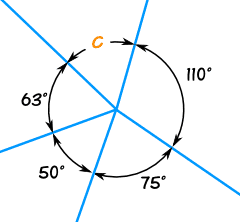
|
Example: What is angle "c"?
To find angle c we take the sum of the known angles and take that from 360°
Sum of known angles = 110° + 75° + 50° + 63°
Sum of known angles = 298°
Angle c = 360° − 298°
Angle c = 62°
|
Angles On One Side of A Straight Line
Angles on one side of a straight line will always add to 180 degrees.
If a line is split into 2 and you know one angle you can always find the other one.
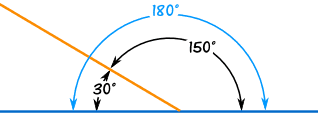
30° + 150° = 180°
Example: If we know one angle is 45° what is angle "a" ?
|
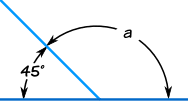
|
Angle a is 180° − 45° = 135°
|
This method can be used for several angles on one side of a straight line.
Example: What is angle "b" ?
|
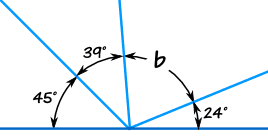
|
Angle b is 180° less the sum of the other angles.
Sum of known angles = 45° + 39° + 24°
Sum of known angles = 108°
Angle b = 180° − 108°
Angle b = 72°
|
Interior Angle
An Interior Angle is an angle inside a shape.
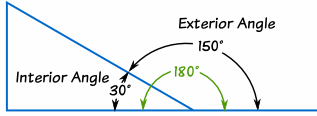
Exterior Angle
The Exterior Angle is the angle between any side of a shape, and a line extended from the next side.

Interior Angles of Polygons
An Interior Angle is an angle inside a shape.

Triangles
The Interior Angles of a Triangle add up to 180°
|

|
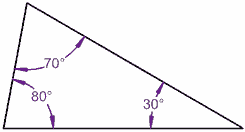
|
|
90° + 60° + 30° = 180°
|
80° + 70° + 30° = 180°
|
|
It works for this triangle!
|
Let's tilt a line by 10° ...
It still works, because one angle went up by 10°, but the other went down by 10°
|
Quadrilaterals (Squares, etc)
(A Quadrilateral has 4 straight sides)
|
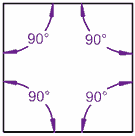
|

|
|
90° + 90° + 90° + 90° = 360°
|
80° + 100° + 90° + 90° = 360°
|
|
A Square adds up to 360°
|
Let's tilt a line by 10° ... still adds up to 360°!
|
|
The Interior Angles of a Quadrilateral add up to 360°
|
Because there are Two Triangles in a Square
|
The interior angles in this triangle add up to 180°
(90°+45°+45°=180°)
|

|
... and for this square they add up to 360°
... because the square can be made from two triangles!
|
Pentagon
|
|
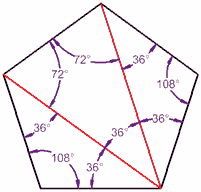
|
A pentagon has 5 sides, and can be made from three triangles, so you know what ...
... its interior angles add up to 3 × 180° = 540°
And if it is a regular pentagon (all angles the same), then each angle is 540° / 5 = 108°
(Exercise: make sure each triangle here adds up to 180°, and check that the pentagon's interior angles add up to 540°)
|
|
|
The Interior Angles of a Pentagon add up to 540°
|
The General Rule
Each time we add a side (triangle to quadrilateral, quadrilateral to pentagon, etc), we add another 180° to the total:
|
|
|
|
If it is a Regular Polygon (all sides are equal, all angles are equal)
|
|
Shape
|
Sides
|
Sum of
Interior Angles
|
Shape
|
Each Angle
|
|
Triangle
|
3
|
180°
|

|
60°
|
|
Quadrilateral
|
4
|
360°
|

|
90°
|
|
Pentagon
|
5
|
540°
|

|
108°
|
|
Hexagon
|
6
|
720°
|

|
120°
|
|
Heptagon (or Septagon)
|
7
|
900°
|

|
128.57...°
|
|
Octagon
|
8
|
1080°
|

|
135°
|
|
Nonagon
|
9
|
1260°
|

|
140°
|
|
...
|
...
|
..
|
...
|
...
|
|
Any Polygon
|
n
|
(n-2) × 180°
|

|
(n-2) × 180° / n
|
So the general rule is:
Sum of Interior Angles = (n-2) × 180°
Each Angle (of a Regular Polygon) = (n-2) × 180° / n
Perhaps an example will help:
Example: What about a Regular Decagon (10 sides) ?
|

|
|
Sum of Interior Angles
|
= (n-2) × 180°
|
|
|
= (10-2)×180° = 8×180° = 1440°
|
And it is a Regular Decagon so:
Each interior angle = 1440°/10 = 144°
|
Exterior Angles of Polygons
The Exterior Angle is the angle between any side of a shape,
and a line extended from the next side.
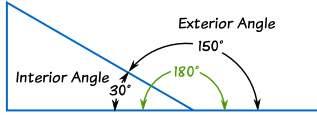
Note: when you add up the Interior Angle and Exterior Angle you get a straight line, 180°.
Polygons
A Polygon is any flat shape with straight sides
|
The Exterior Angles of a Polygon add up to 360°
|
| |
|
In other words the exterior angles add up to one full revolution
(Exercise: try this with a square, then with some interesting polygon you invent yourself.)
Note: This rule only works for simple polygons
|
|
Here is another way to think about it:
Each lines changes direction until you eventually get back to the start:
|
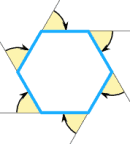
|
 الاكثر قراءة في الهندسة المستوية
الاكثر قراءة في الهندسة المستوية
 اخر الاخبار
اخر الاخبار
اخبار العتبة العباسية المقدسة


